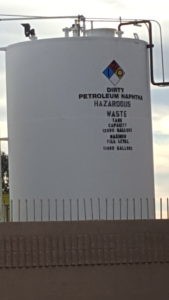A Small Quantity Generator of hazardous waste (SQG) that treats or stores (i.e. accumulates) hazardous waste in a tank as defined in 40 CFR 260.10 – and explained in detail in an earlier article (What is a Hazardous Waste Tank?) – must comply with 40 CFR 262.16(b)(3) Accumulation of hazardous waste in tanks.
An SQG that accumulates hazardous waste in a tank must comply with the following general operating conditions:
- Comply with the regulations of §265.17(b) which usually applies solely to the accumulation of ignitable, reactive or incompatible hazardous waste, but here applies to all hazardous waste in tanks at an SQG. In order to comply with §265.17(b) the treatment or storage of hazardous waste in tanks at an SQG must not:
- Generate extreme heat or pressure, fire or explosion, or violent reaction;
- Produce uncontrolled toxic mists, fumes, dusts, or gases in sufficient quantities to threaten human health;
- Produce uncontrolled flammable fumes or gases in sufficient quantities to pose a risk of fire or explosions;
- Damage the structural integrity of the device or facility containing the waste; or
- Through other like means threaten human health or the environment.
- Do not place hazardous waste or treatment reagents in a tank if it would cause the tank to fail.
- Ensure at least 60 centimeters (2 ft) of freeboard for uncovered tanks unless the tank’s containment system is able to hold the volume of the top 60 cm.
- There must be a way to stop the flow of hazardous waste into the tank in the event of a leak or overflow from the tank caused by system failure.
- Inspections must be completed pursuant to Table 1, below and §262.16(b)(3)(iii).
Table 1: Required Inspections of Hazardous Waste Tank Systems at an SQG
| To be inspected | Frequency of inspections |
| Discharge control equipment (e.g., waste feed cutoff systems, by-pass systems, and drainage systems). | “at least once each operating day” Or at least weekly if the requirements of §262.16(b)(3)(iv) are met. |
| Data gathered from monitoring equipment (e.g., pressure and temperature gauges) | “at least once each operating day” Or at least weekly if the requirements of §262.16(b)(3)(iv) are met. |
| The level of waste in the tank, if uncovered | “at least once each operating day” Or at least weekly if the requirements of §262.16(b)(3)(iv) are met. |
| The construction materials of the tank to detect corrosion or leaking of fixtures or seams. | “at least weekly” |
| The construction materials of, and the area immediately surrounding, discharge confinement structures (e.g., dikes) to detect erosion or obvious signs of leakage (e.g., wet spots or dead vegetation). | “at least weekly” |
And just what are the requirements of §262.16(b)(3)(iv) referred to above? Well, The tank must have full secondary containment and either uses leak detection equipment to alert facility personnel to leaks or has established workplace practices to ensure leaks are promptly identified. The regulations do not specify what type of “leak detection equipment” is acceptable or what form the “established workplace practices” must be. Suffice to say the burden of proof is on the generator who must document the use of the alternate inspection schedule and a description of the “established workplace practices” in the facility’s operating record.
- Upon closure of the facility, the generator must remove all hazardous waste from tanks, discharge control equipment, and discharge confinement structures.
- Ignitable or reactive waste must not be placed in a tank, unless:
- The waste is treated, rendered, or mixed before or immediately after placement in a tank so that:
- The resulting waste, mixture, or dissolution of material no longer meets the definition of ignitable or reactive waste per 40 CFR 261.21 or 40 CFR 261.23, and;
- § 265.17(b) is complied with (see above).
- The waste is treated, rendered, or mixed before or immediately after placement in a tank so that:
Or…
- The waste is stored or treated in such a way that it is protected from any material or conditions that may cause the waste to ignite or react; or
- The tank is used solely for emergencies.
- Ignitable or reactive waste accumulated in covered tanks must comply with the buffer zone requirements for tanks contained in Tables 2-1 through 2-6 of the National Fire Protection Association’s “Flammable and Combustible Liquids Code,” (1977 or 1981) (incorporated by reference, see § 260.11).
- Incompatible wastes, or incompatible wastes and materials, (see appendix V for examples) must not be placed in the same tank, unless § 265.17(b) (again, see above) is complied with.
- Hazardous waste must not be placed in an unwashed tank which previously held an incompatible waste or material, unless § 265.17(b) (you know) is complied with.
Contact me with any questions you may have about the generation, identification, management, and disposal of hazardous waste Daniels Training Services, Inc. 815.821.1550 |
And that’s it! Unlike a Large Quantity Generator of hazardous waste (LQG), an SQG is not subject to the RCRA air emission standards of §265, Subparts AA, BB, & CC.
No matter your hazardous waste generator status or whether you manage hazardous waste in tanks, containers, drip pads, or containment buildings, you must comply with the training requirements of the RCRA regulations. Contact me for a free consultation of your training requirements.
